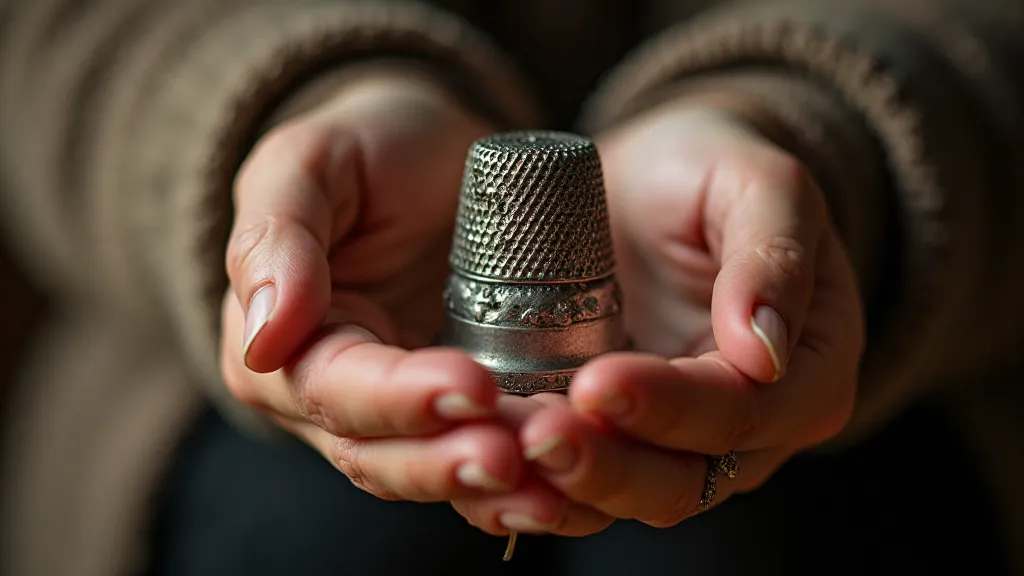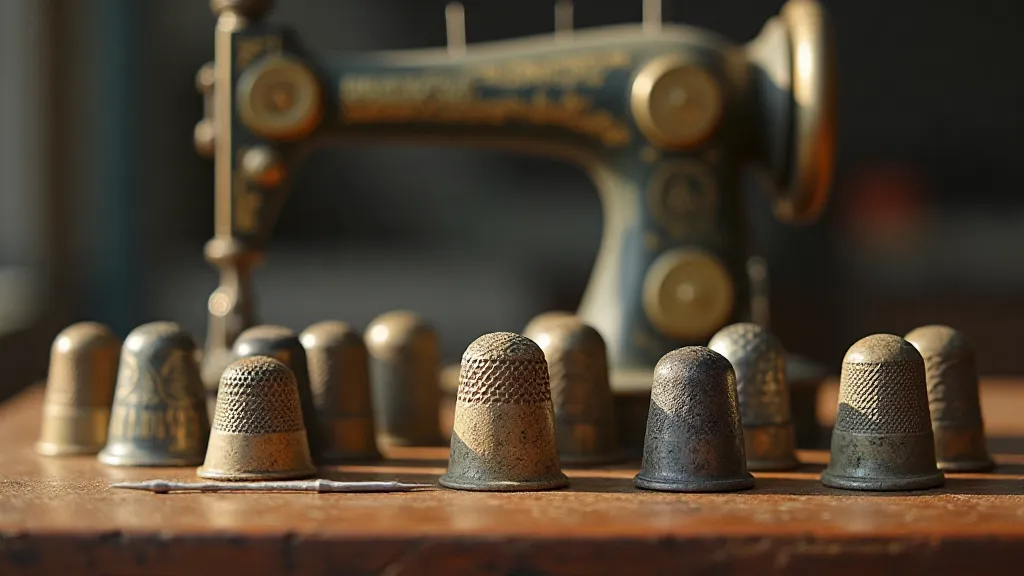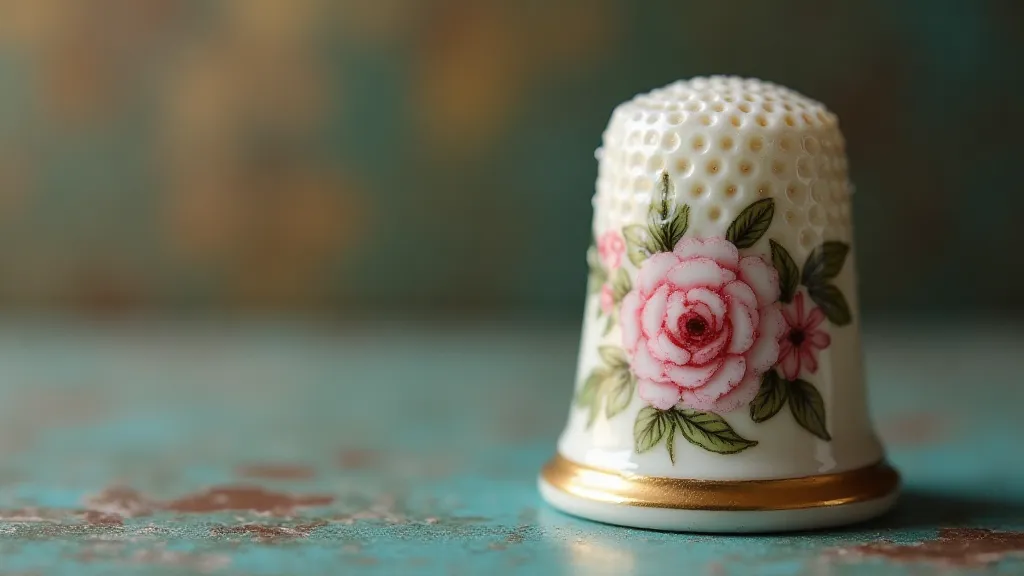Ephemeral Echoes: The Vanishing Art of Hand-Sewn Textiles & Thimble Companionship
There's a quiet melancholy that settles when you hold an antique thimble. It's more than just the cool weight of silver or the delicate feel of porcelain; it's the echo of a skill fading, a world shifting, and the intimate companionship of a tiny tool witnessing generations of meticulous work. The rise of mass-produced clothing has, undeniably, diminished the need for hand-sewing. While this advancement brought convenience and accessibility, it also subtly distanced us from the profound connection our ancestors held with the process of creation, and the little helpers like thimbles that made it possible.
My grandmother, Elsie, possessed a boundless patience and a seemingly endless supply of fabric scraps. I remember, as a child, sitting at her feet, mesmerized by the rhythmic *zip, zip, zip* of her needle, guided by the reassuring press of her thimble. It wasn’t just sewing; it was an act of love, transforming discarded materials into warm quilts and charming little dresses for her grandchildren. Her thimble, a simple silver one, worn smooth with years of service, felt imbued with her spirit—a tangible link to her wisdom and dedication. That thimble, now carefully stored, represents far more than just a sewing accessory; it embodies a lineage of creativity and care that I desperately hope to pass on.

The Historical Significance: More Than Just a Tool
The history of thimbles is fascinating, intertwined with the evolution of sewing itself. Initially, fingers bore the brunt of the needle’s journey. The earliest forms of protection weren’t even dedicated thimbles; they were often finger stalls made of leather or metal, attached to the finger to shield it from injury. The independent thimble, as we know it today, began to appear in Europe during the 15th century, coinciding with the increased popularity of sewing as a vital skill for both domestic life and burgeoning industries like tailoring and embroidery. Before the advent of sewing machines, virtually every household relied on hand-sewing for clothing, linens, and repairs. This made thimbles essential tools, passed down through families, becoming heirlooms in their own right.
Early thimbles were typically made of metals like pewter, brass, and later, silver. The quality of the metal often reflected the owner’s social standing – silver being reserved for those of higher status. During the Victorian era, thimble production flourished, leading to an astonishing diversity of designs and materials. Porcelain thimbles, often elaborately decorated with painted scenes and intricate floral patterns, became fashionable. Bone, horn, and even carved wood were also utilized. The craftsmanship involved was often remarkable, with artisans demonstrating exceptional skill in creating these small but vital objects.
A Spectrum of Materials & Design
The materials used in thimble creation reveal a lot about the era and the maker’s resources. Pewter thimbles, common in the 16th and 17th centuries, offer a glimpse into the everyday lives of ordinary people. The slightly rough texture of pewter, the imperfections in the casting, tell a story of practicality and affordability. Silver thimbles, with their polished surfaces and often-engraved designs, represent a higher level of refinement. I’m particularly drawn to the German silver thimbles of the late 19th century – often delicately chased with floral motifs and bearing the maker’s mark. These marks, though small, provide invaluable information for collectors – a tiny window into the artisan’s identity and their place in history. The intricate details and precision involved often harken back to the legacy of master craftsmen, sometimes even extending to fields like clockmaking, where similar levels of skill and artistry were required - demonstrating the clockmaker’s legacy in miniature.
The designs themselves evolved dramatically. Early thimbles were primarily functional – simple, rounded shapes designed for protection and ease of use. Later, Victorian-era thimbles became increasingly ornate, incorporating intricate engravings, embossed designs, and even miniature painted scenes. There were novelty thimbles shaped like animals, fruits, or even miniature buildings - whimsical creations that reflected the era's love for ornamentation and storytelling. Certain regions developed their own distinctive styles. For instance, Swiss thimbles are often characterized by their delicate filigree work, while Russian thimbles frequently display elaborate niello work—a technique involving the inlaying of blackened silver. The sheer volume of these items also tells a story of their significance, and how a pocketful of memories could be encapsulated within a single collection, travelling across generations and continents.

Collecting & Restoration: Preserving a Legacy
Today, antique thimbles are sought after by collectors who appreciate their historical significance, artistic merit, and connection to a bygone era. While the monetary value can vary greatly depending on the material, age, rarity, and condition, the true value lies in the stories they hold. A thimble bearing a maker’s mark can be traced back to a specific artisan, offering a tangible link to a skilled craftsperson. A thimble passed down through a family offers a glimpse into the lives of previous generations. The significance of these objects isn't merely aesthetic; they're threads in the tapestry of human history, reflecting migration patterns, economic shifts, and the enduring power of handmade goods.
Restoring antique thimbles requires a delicate touch. Harsh cleaning methods can damage the patina and potentially devalue the piece. Gentle cleaning with a soft cloth is often the best approach. Significant damage, such as dents or cracks, should ideally be left untouched, as attempting repairs can be risky and may compromise the integrity of the thimble. Preserving the original condition is paramount, allowing the piece to tell its own story of time and use. A seasoned collector understands that preserving the original character of a thimble – the tiny imperfections, the wear and tear – is far more valuable than achieving a pristine, artificial shine.
Identifying antique thimbles can be challenging, but it’s a rewarding pursuit. Researching maker’s marks, familiarizing oneself with regional styles, and consulting with experienced collectors are invaluable resources. Online forums and auction sites dedicated to antique sewing collectibles can also provide valuable information and insights. The journey of discovery, tracing the origins and history of a single thimble, can be deeply enriching, connecting you to a network of fellow enthusiasts and unlocking a wealth of knowledge about this often-overlooked piece of history.

A Silent Witness to History
Holding an antique thimble is more than just handling a small object; it's connecting with a history of skill, perseverance, and creativity. It’s a reminder of a time when hand-sewing was not merely a craft but a fundamental life skill, essential for survival and self-sufficiency. It’s a tangible link to the women (and men) who dedicated countless hours to creating clothing, linens, and other essential items for their families and communities. As the echoes of hand-sewing fade, preserving and appreciating these tiny companions—these silent witnesses to history—becomes increasingly vital. The subtle beauty and functionality of these objects, often taken for granted in a world dominated by mass production, speaks volumes about the ingenuity and resourcefulness of previous generations. These weren't just tools; they were extensions of the hands and hearts of those who used them, each one imbued with a unique story waiting to be uncovered. It’s incredible to think of how these seemingly insignificant objects could carry so much cultural weight, reflecting the values and traditions of their time.
The legacy of these artisans extends far beyond the objects they created. They were keepers of a vital skill, passing down knowledge and techniques through generations. Their dedication to quality and craftsmanship serves as an inspiration to us today, reminding us of the importance of valuing handmade goods and supporting traditional crafts. Perhaps, by understanding their significance, we can rekindle a sense of connection to the artistry and dedication of generations past, and inspire a renewed appreciation for the beauty of handmade creations. The care and attention to detail invested in each thimble speak to a different era – one where objects were made to last, not to be discarded. It's a poignant reminder of the transient nature of modern consumerism and a call to rediscover the value of durability, craftsmanship, and the enduring power of human creativity.





